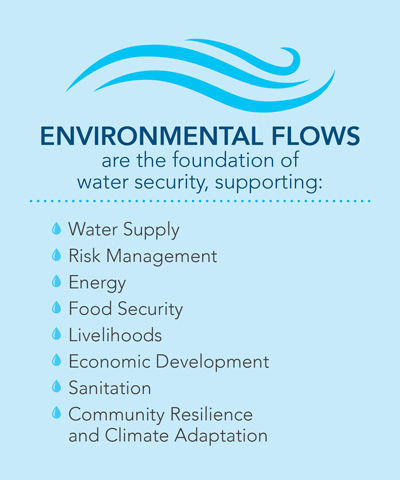
Water and Ecosystems: The Importance of Environmental Flows
John Parker of SWP partner Tetra Tech explains how natural flows support the environment.
Water is an essential resource that underpins human societies and is a requirement for ecosystem health. Availability of clean and reliable supplies of water is central to many, if not all, development challenges. Through water management infrastructure, including dams and reservoirs, irrigated areas, levees and canals, we secure water supplies and manage risks to communities from excess (floods) and shortage (drought). As water management infrastructure is built in river basins, flow regimes are altered to accommodate human needs and reduce uncertainty in water availability. Under natural conditions, communities may exclusively depend on precipitation during the growing season. With a dam, water can be stored, dramatically reducing uncertainty in water supply.
While flow modification is generally beneficial in terms of managing risk for single purposes (e.g. water supply for an irrigation district) it can also limit water availability for other downstream purposes (e.g. water supply for riverine communities) or reduce water availability for ecosystem health and biodiversity and the multiple human benefits derived from natural systems.
 The natural benefits of flows and related processes such as nutrient enrichment of agricultural lands, support of fisheries, transportation, wastewater flushing, prevention of salt water intrusion in coastal systems, and support of biological productivity, are typically hard to quantify and are usually not represented by an individual economic sector as in the case of urban water supply, agriculture or hydropower. As a result, the detrimental impacts of flow regime alteration often become clear once water is over-allocated, key processes (e.g. episodic flooding of floodplains) become sparse orabsent, and ecological degradation becomes evident.
The natural benefits of flows and related processes such as nutrient enrichment of agricultural lands, support of fisheries, transportation, wastewater flushing, prevention of salt water intrusion in coastal systems, and support of biological productivity, are typically hard to quantify and are usually not represented by an individual economic sector as in the case of urban water supply, agriculture or hydropower. As a result, the detrimental impacts of flow regime alteration often become clear once water is over-allocated, key processes (e.g. episodic flooding of floodplains) become sparse orabsent, and ecological degradation becomes evident.
The concept of environmental flows (E-flows) emerged at the end of the last century in response to a legacy of dramatic alteration of many waterways. Theoretical E-flows frameworks have shifted toward more applied management strategies and from a very specific focus on maintaining minimal “in-stream” water to more holistic evaluation of basin level water requirements. This shift is driven by a growing body of knowledge documenting biological benefits of E-flows and increasingly clear economic benefits.
The most common definition (Brisbane Declaration, 2007) describes E-flows as “the quantity, timing, and quality of water flows required to sustain freshwater and estuarine ecosystems and the human livelihoods and well‐being that depend on these ecosystems.” While healthy ecosystems clearly benefit people, ecosystem requirements are not recognized as competing water demands in many basins around the world. As a result, we often over-allocate and over-use water resources with unanticipated consequences. The hydrological cycle of a river basin, driven by dynamic climates, determines how much water is available. Sustainably managing water resources and allocation therefore requires a robust understanding of the hydrologic cycle of a river basin and the wide range of current and future human and ecosystem water demands.
Over abstraction and mismanagement of water resources, often in water limited and/or highly developed basins such as the Murray-Darling in Australia, the Orange River in South Africa, the Chapala-Lerma of Central Mexico, and the Columbia River in the US, have led to programs aimed at conserving environmental flows. These programs have generally focused almost exclusively on preserving in-stream flows for preservation of ecosystem health and biodiversity. A critical hurdle for implementing E-flows programs in much of the developing world is building the understanding that natural flows support both environmental objectives and many other objectives with important benefits for the poor and vulnerable.
While E-flows are now recognized as important for ecosystem health, they have the potential to provide communities with an essential reserve or buffer against natural variability in water availability, climate change, and shifting human needs. Characterizing and preserving E- flows can complement water allocation plans to preserve water for ecosystems and to provide a reserve of water that can accommodate numerous human needs. Framed properly, environmental flows can be implemented in such a way that competing needs between multiple water users, such as farmers and hydropower generators, can be met.
Related Projects

